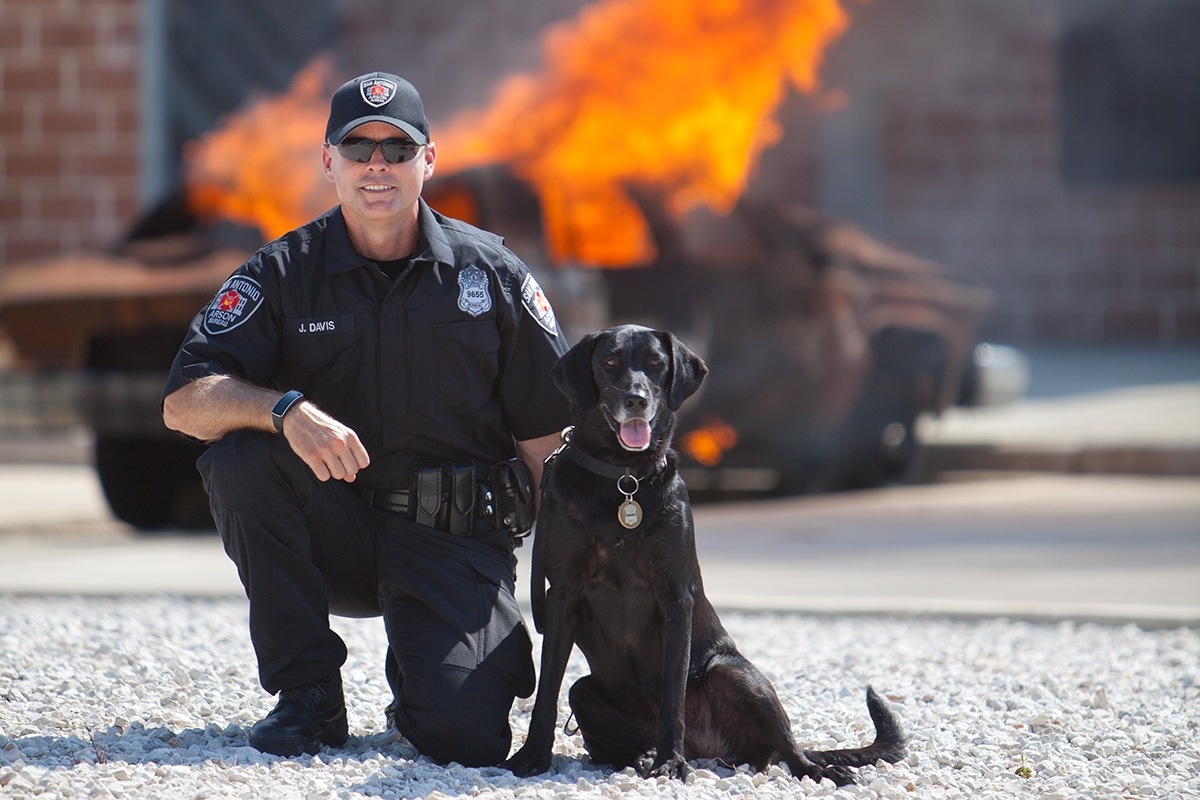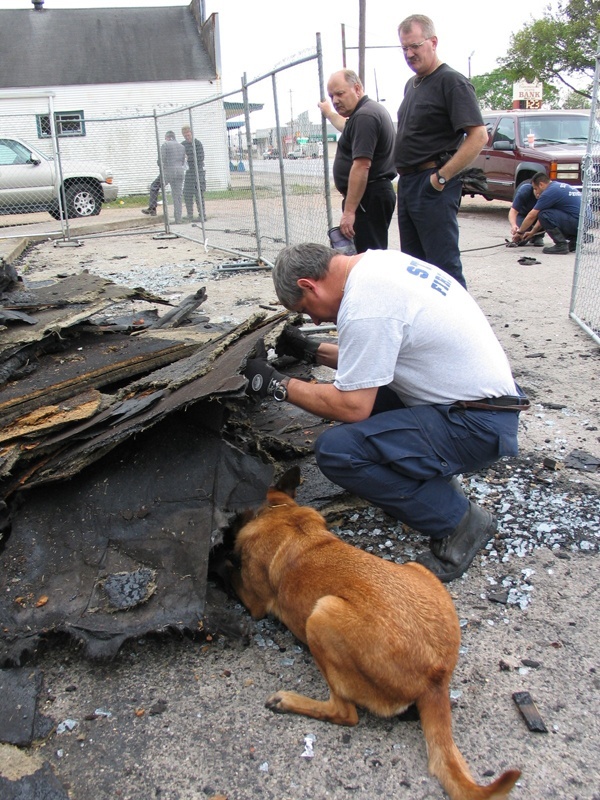Walking slowly, Kai carefully examines the charred remains on the ground. The structure around her is completely burned. A highly qualified expert in detecting liquid accelerants such as gasoline and lighter fluid, Kai has earned the deep respect and appreciation of the man standing near her, San Antonio firefighter Justin Davis. With Kai at his side, Davis knows the fire investigators stand a good chance of finding out how the fire started and perhaps even the person who ignited it.
The olfactory abilities of dogs are legendary in finding criminals, drugs and explosives, but Kai happens to be specifically trained to detect minute traces of flammable liquids.
“A dog’s nose is 100,000 times more sensitive than a human nose,” Davis says.
Dogs have 200 million–300 million odor receptors in their nose, detecting odors in parts per trillion. For comparison, a human nose has about 5 million odor receptors.
An arson dog like Kai can detect and communicate the presence of a flammable liquid at a fire scene.
“We are looking for trace amounts of ignitable liquid left behind after somebody starts a fire,” says Tommy Pleasant, captain of canine operations for fire/arson investigation with the Texas State Fire Marshal’s Office. “We allow the dog to sniff the entire scene to see if there’s anything left behind after the fire.”
Pleasant explains that arson dogs go into burned-out vehicles, houses, other structures and even open fields where an arsonist might have escaped. If a flammable liquid is detected, the dog will communicate with the handler by sitting, tapping their paw, making eye contact or barking.
“Arson is a hard crime to investigate,” Davis says. “A lot of the evidence is either destroyed or damaged by the fire. It’s also a crime that often happens during the middle of the night, so by the time an investigator gets to the scene, they’re already behind the curve.”
What an arson dog like Kai does, however, helps even the playing field.
“Instead of taking hours, days or even longer for an arson investigator to find this evidence, an arson dog can do it in minutes,” Davis says. “The dog gives a fire investigator a good place to start looking.”
If the investigation leads to a suspect, the police can even put the suspect’s clothing in a lineup and deploy the dog’s nose to see if that person might have spilled the same flammable liquid on themselves.
It’s not just her nose that makes Kai perfect for this job. She loves to work and can navigate hazardous environments, making sure she and her handler stay safe. Dogs like Kai are generally trained in one of two ways, based on specific behavioral drives: food reward or play drive.
“Our dogs are trained by focusing on the drive for food,” Davis explains. “Instead of feeding her [Kai] by placing her food in a bowl, I feed her by hand as a reward for associating food with giving a response at the source of an ignitable liquid.”
The dogs used by the state fire marshal’s office, however, are trained slightly differently.
“We use only Belgian Malinois,” Pleasant says. “This breed is well-known for their prey or play drive.”
Pleasant explains that these dogs have high hunt, air scent, retrieve and prey drives. When the dog follows the scent to the source and communicates with the handler, they’re rewarded with a toy to chase down and play with.
Just like a food reward, this method also satisfies a dog’s basic needs.
Together, the handler and the dog work through five weeks of training. The training is expensive.
“Fire departments may qualify for an arson dog free of charge by applying for a scholarship,” Davis says. Programs like the State Farm Arson Dog Program award these scholarships to help offset the cost of the training. Once the dog and handler are certified as a team, they’re ready to begin work in their jurisdiction.
State Farm alone has put nearly 400 arson dogs to work since 1993, seeing the investment as a way to diminish the cost of this crime. Each year, billions of dollars in property and hundreds of lives are lost because of intentionally set fires.
Above all, the relationship between an arson dog and its handler is of primary importance. The pair bonds from day one.
Kai is a Labrador mix rescued from a dog shelter. She’s proven to be an invaluable resource to Davis, a trusted companion and a member of his family. She was even named 2014 Arson Dog of the Year by American Humane.
“They’re like our kids,” Pleasant says, echoing that special bond. “They know how we’re feeling and we know how they’re feeling. For example, at a fire scene where there have been fatalities, our dogs can really sense that we’re upset. On one of these occasions, my dog approached me as if to give me a hug and tell me it was going to be alright.
“We’re loving on them and they are loving on us. We build this bond that is unbreakable—it’s a deep trust of one another.”
Pleasant explains that it’s essential for the dogs to live in the home of their handlers, not just because they respond to fires at all hours, but also because the dogs become part of the family.
“Our dogs trust us enough to take care of them,” he says, “and we’re trusting the dogs to take care of us.”
A working arson dog has a kind of “switch” that turns off and on, depending on circumstances. When the dog comes home after working a fire scene, it’s “free dog” time; it can relax, unwind and enjoy some fun. There’s no training.
“After working, we just play with the dogs and have a good time,” Pleasant says. “But when we open that gate to the backyard, walk out to the truck and load our dogs into their kennels, they become very excited. They know it’s time to go to work.”





